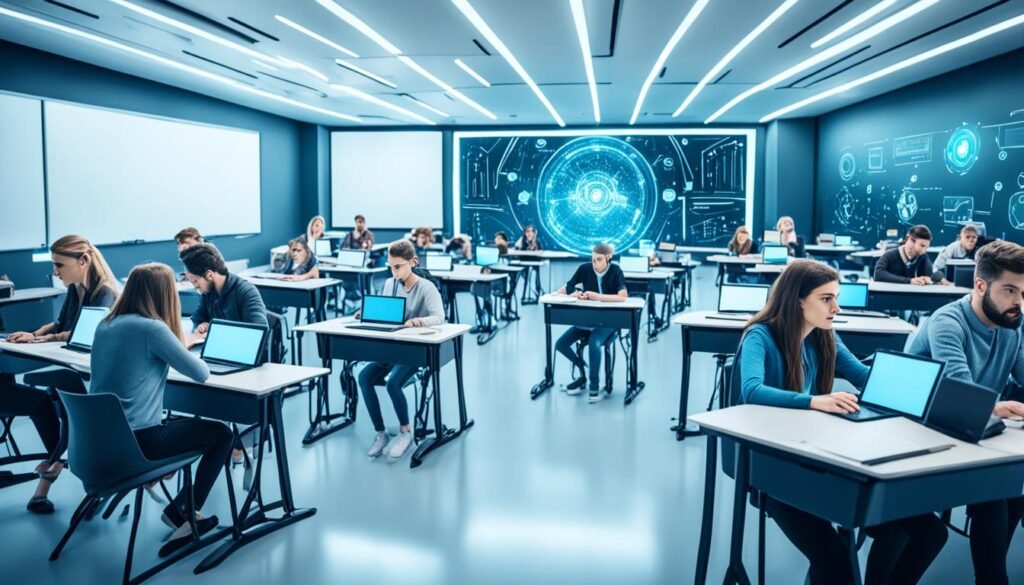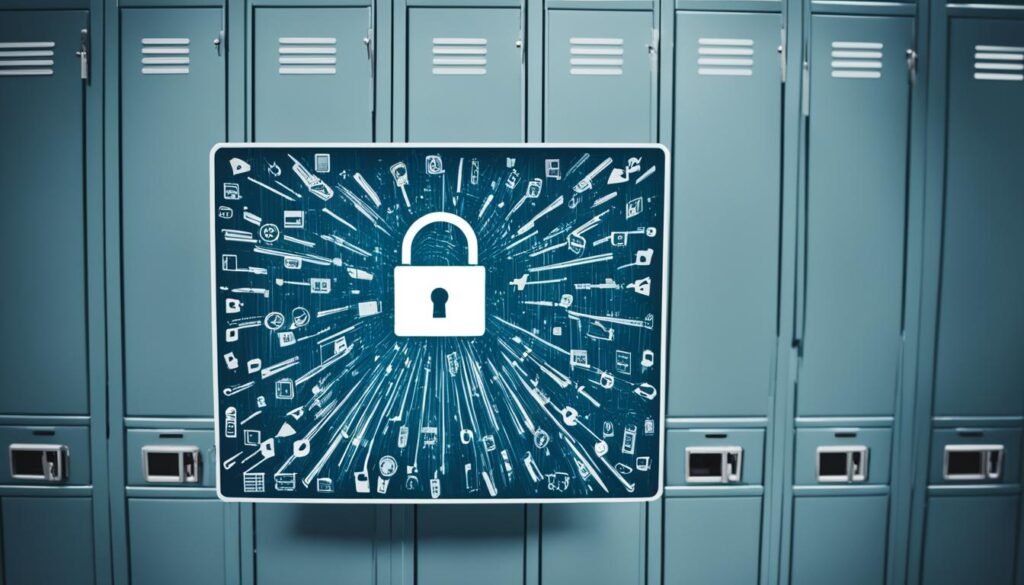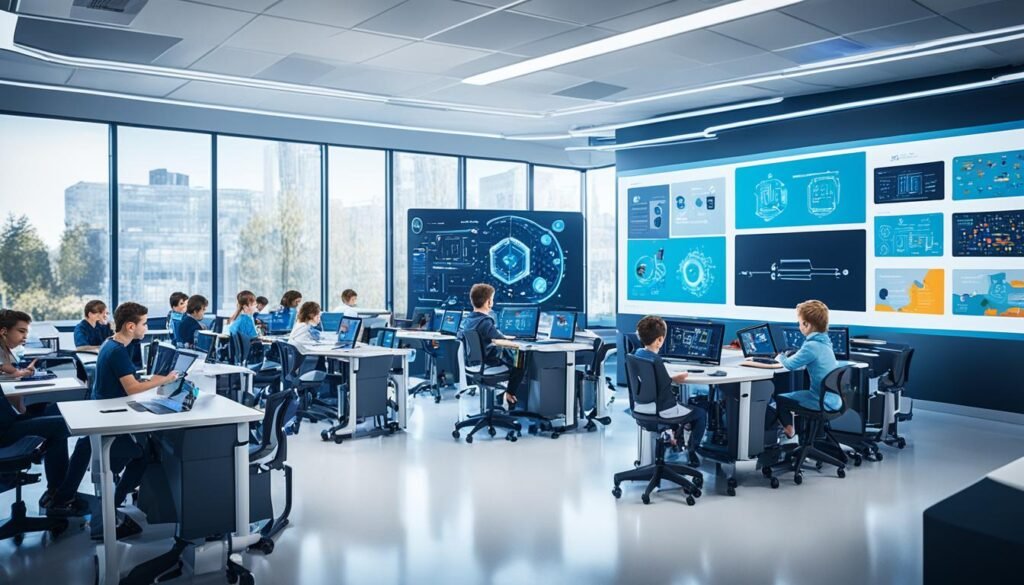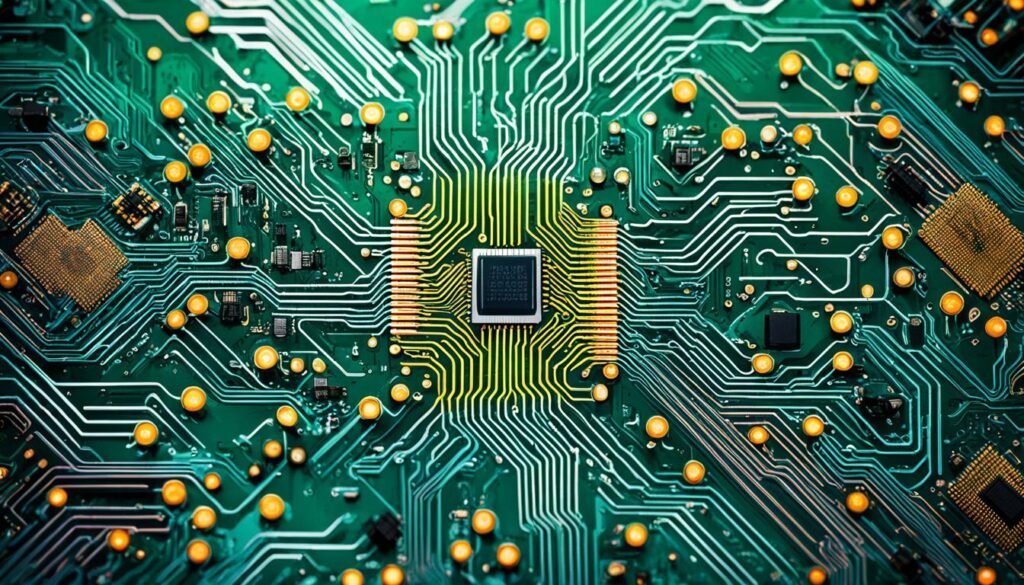Artificial intelligence (AI) is changing education fast, with almost 60% of teachers using AI tools in class. But, this rise of AI in schools brings many challenges. Educators, students, and policymakers need to tackle these issues. It’s important to know the problems and how to deal with them as AI changes how we learn.
Key Takeaways
- AI-powered tutoring and learning platforms can provide valuable support, but also raise concerns about data privacy and student safety.
- Generative AI tools that produce essays and other assignments can enable academic dishonesty, leading to unfair accusations for some students.
- Disparities in access to advanced AI tools can exacerbate learning inequities among students from diverse backgrounds.
- Educators need comprehensive training to understand the benefits and limitations of AI, as well as how to promote ethical use in the classroom.
- Policymakers must work to update regulations and guidelines to address the rapidly evolving landscape of AI in education.
The Rise of AI in Education
AI is now a big part of our lives, from helping with daily tasks to making personalized suggestions. In education, a key area of AI growth is generative AI. This type of AI learns from huge amounts of data to do many things, like making text, images, and code that looks real.
Generative AI: What Is It?
Large Language Models (LLMs) are a kind of generative AI. They learn from lots of text to make text that sounds like a human wrote it. Examples include ChatGPT, Microsoft Bing Chat, Google Bard, and Anthropic Claude 2. These tools could change how we learn, making it more personal and helping with grading and tutoring.
- A study by HolonIQ says 75% of schools use AI to help students do better.
- UNESCO found only 10% of schools have rules for using generative AI, showing a need for better planning.
- McKinsey thinks up to 70% of what employees do can be done by AI, including in schools.
There’s a lot of excitement about AI in schools, but there are also worries. Teachers are concerned that AI might hurt how students learn and get ready for college, making them think less critically or treating everyone the same. Teachers also fear students might use AI to cheat more easily with tools that write essays.
As AI becomes more common in schools, it’s important for schools to have rules and plans for using it right. By teaching students to think critically with AI, teachers can help them deal with a world full of technology.
Challenges of AI in the Classroom
AI technology is moving fast, making us think about its effect on schools. As AI enters classrooms, teachers face many challenges to use it right and safely.
One big issue is getting teachers ready for AI. Many don’t have the training or tools to use AI tools well in class. This can mean they don’t use AI to its full potential to help students learn.
Privacy and security are also big worries with AI in schools. AI systems handle student data, which makes us think about keeping that data safe. Teachers must make sure AI tools are secure and respect privacy rules.
- AI tools can sometimes give wrong or unreliable answers, which can make students and parents doubt the school.
- Not all students can get to AI tools equally, which could leave some behind.
To overcome these problems, teachers need to keep up with AI news and how it affects schools. They should push for more money for training teachers on using AI responsibly in class.
| Challenge | Impact | Potential Solutions |
|---|---|---|
| Teacher Preparedness | Suboptimal implementation and missed opportunities to harness the potential of AI | Increased investment in teacher training and professional development programs |
| Privacy and Security | Concerns about data privacy and the potential for misuse or unauthorized access | Robust privacy policies and vetting of AI products for security risks |
| Unreliable Outcomes | Undermined trust and confidence in the educational system | Careful evaluation and monitoring of AI-powered tools |
| Accessibility and Equity | Creation of a digital divide among students | Ensuring equitable access to AI-powered resources |
By tackling these issues, teachers can make AI a game-changer in the classroom. This will lead to a more engaging, tailored, and successful learning experience for everyone.

ai problems with school
Safe Use and Data Privacy
AI is becoming more common in schools, raising concerns about data privacy and security. Schools need to think about how they handle student data for AI tools. They must protect this sensitive info well.
Schools should make rules for using AI safely. These rules should say what data can be collected, why, and how it’s kept safe. Teachers and tech teams need to work together to check AI tools for risks.
Keeping student data safe is key when using AI in schools. Schools should use strong encryption and controls to protect data from hackers. By doing this, they make sure AI helps learning without risking students’ privacy.
| Statistic | Explanation |
|---|---|
| Seattle, New York City Public Schools, and the Los Angeles Unified School District imposed bans on AI chatbots on their campuses. | These districts are being careful with AI chatbots in schools. They want to keep student data safe and secure. |
| 75% of students believe ChatGPT can help them learn faster, according to a national survey conducted by the Walton Family Foundation in May 2023. | Many students think AI can make learning better. This shows we need to use AI wisely to keep data safe. |
| 73% of teachers agree that ChatGPT can help students learn according to the same survey by the Walton Family Foundation. | Teachers also see AI as a helpful tool for learning. We need good policies to handle data privacy and security. |

AI is changing education, and schools must use it safely. By making clear rules, working with tech experts, and keeping data private, schools can use AI’s benefits. This way, they protect students’ personal info too.
Learning With AI, Learning About AI
As AI technology grows in schools, it’s vital that teachers and students understand these tools well. Teachers need to learn about AI first to feel ready to use it with students. This helps teachers help students learn the skills needed in an ai classroom integration world.
Students must learn how to use ai student learning tools and understand AI’s workings. This ai digital literacy helps them make smart choices and question the info they find in an AI world.
- Educate teachers on the basics of AI, including how it works and its potential applications in the classroom.
- Provide resources and training to help teachers integrate AI tools seamlessly into their lesson plans and teaching practices.
- Encourage students to explore the inner workings of AI systems, understand their limitations, and develop a critical eye towards the information they receive.
- Incorporate discussions about the ethical implications of AI, such as data privacy, algorithmic bias, and the impact on the workforce, into the curriculum.
By focusing on AI literacy for teachers and students, schools can make AI in the classroom work well and responsibly. As AI keeps evolving, this knowledge will be key for navigating the ai-powered education future.
“The future is already here – it’s just not very evenly distributed.” – William Gibson

The Role of Computer Science Education
As AI becomes more powerful, computer science education is key to getting students ready for the future. It teaches them about AI and gives them the skills they need. This education helps students understand and use AI in their lives.
In California, computer science is seen as a vital part of our digital world. It teaches students about computing and how to use technology wisely. This knowledge helps them become digital citizens who can use AI for good and fight for fairness.
- The release of Generative Artificial Intelligence (Gen AI) in November 2023 started talks on how CS education will change.
- Some big tech companies laid off many workers because they use automated tools like GitHub CoPilot for coding.
- AI tools are quickly becoming popular in schools, making teachers and leaders worried about past failures in education technology.
- Chatbots can code faster than people, showing how automation helps, but AI can also make mistakes.
Studies show that making students creative in programming helps them think like computer scientists. This is important for dealing with AI. We need strong policies on AI in schools to protect everyone.
States should make rules about using AI in schools. These rules should cover ethical use and protect against bias and privacy issues. It’s important to focus on making systems safe and fair.
| Statistic | Value |
|---|---|
| $1.6 million commitment by the Computer Science Teachers Association to revamp CSTA K-12 Computer Science Standards | $1.6 million |
| 53% of high schools in the United States offer computer science courses (2022, Code.org) | 53% |
| Nearly 88% of high school students in Pennsylvania attend a school that offers a computer science course | 88% |
Teachers of computer science are crucial in guiding how AI fits into our lives. They teach students to use technology in a way that respects human values. It’s important to include computational thinking (CT) skills and focus on people in the curriculum.
Teachers need to keep learning and sharing resources to stay ahead. Groups like the Computer Science Teachers Association (CSTA) offer help. This way, teachers can prepare students for the AI future.

Fundamental AI Skills for Educators
AI is changing education fast. Educators need to learn about this new tech. Through professional learning initiatives, they can get the skills to teach in an AI world. This helps them give students a complete education.
Professional Learning and Ethical Use
Teachers must keep learning to know how AI works and its limits. This helps them teach students in a world full of AI. They should learn how to use AI safely and ethically. This means keeping student data private and using AI tools wisely in class.
- Learn about AI basics like machine learning, natural language processing, and computer vision.
- Find ways to add AI tools to lessons without losing student interest or focus.
- Understand AI’s biases and how to fix them in teaching.
- Keep up with new AI tech and how it changes teaching and learning.
By focusing on AI professional development and ethical use, teachers can prepare students for an AI-filled future. This way, students will think critically and handle AI challenges with confidence.
“Preparing students for the AI-powered future requires educators to first understand the technology and its implications. Only then can we effectively integrate AI into the classroom in a way that enhances learning and promotes ethical use.”
As AI becomes more common in classrooms, teachers must lead the change. They need to make sure students have the skills and knowledge for an AI world.
AI’s Potential Impact on Education
AI in education raises both hopes and concerns. Experts believe it can change how we learn for the better. It could make learning more personal, accessible, and efficient, leading to improved student outcomes. But, we need to watch how fast AI changes and study its long-term effects on schools.
One big ai education benefit is making learning more personal. AI can look at each student’s data to tailor lessons to their needs. It can also help with grading, letting teachers focus more on teaching and helping students who need it.
ai personalized learning tools give students instant feedback and help teachers spot where students need help. AI also helps teachers grow by offering new tools and keeping them updated on the latest teaching methods.
AI makes classrooms more efficient by using data to improve teaching. It helps teachers see how students are doing and find the best ways to help them. AI also opens up learning to students in places where it’s hard to get good education.
But, using AI in schools also brings up big questions. Teachers need to make sure AI is used safely and fairly. They must deal with issues like bias, privacy, and making sure AI doesn’t replace human teachers.
As AI gets better, we need to work together to make sure it’s used right in schools. By using the good parts of AI and fixing the problems, we can make learning better for everyone. This will help students get ready for the future.
Navigating the AI-Powered Future
AI is becoming a big part of our lives, even in schools. It’s important for teachers and students to learn how to use AI well. They need to know how these systems work, their good and bad points, and the right way to use them.
Teaching AI literacy and digital citizenship helps students get ready for an AI-filled world. They’ll learn about AI algorithms, data privacy, and how to use these technologies wisely.
Schools should focus on teaching 21st century skills like critical thinking and problem-solving. These skills are key for dealing with an AI-powered future. Students will need to work well with smart systems.
To get ready for this, schools should add AI-readiness to their classes. This means teaching coding and showing students how AI affects the real world. It’s about making them digitally literate for a tech-filled future.
By using AI in education and getting students ready for the future, schools can help the next generation shape the AI world they’ll live in.
“The future is already here – it’s just not very evenly distributed.” – William Gibson
As AI changes education, schools, parents, and students must work together. By being collaborative and informed, we can make sure AI in education is positive. It will prepare students for the future’s challenges and chances.
Conclusion
AI in education brings both good and bad sides. We must tackle privacy, security, and AI tool reliability issues. Yet, AI can greatly improve learning by making it more personal, accessible, and efficient.
By getting educators and students ready for an AI-powered future, schools can use this tech to better student outcomes. This prepares learners for the challenges of the 21st century.
Using ai in education while solving ai challenges opens up new chances for students and teachers. It’s key to build a culture of ai-readiness in your school. This means making sure teachers and students can do well in an AI-based learning world.
The future of education is changing with AI and new teaching methods. By keeping up with changes and using AI’s strengths, you can make your school or district successful. This helps students achieve their goals in the future.
FAQ
What are some key challenges of integrating AI in the classroom?
Integrating AI in the classroom faces challenges like teacher readiness, privacy, and security. It also includes managing AI’s sometimes unreliable results. Plus, making sure all students can use AI equally is a big issue.
How can educators ensure the safe and responsible use of AI in the classroom?
Teachers need to set clear rules for using AI responsibly. They should work with tech teams to check AI tools for privacy or security risks. Also, they must protect students’ data when using AI in teaching.
How can AI enhance personalization, accessibility, and efficiency in learning?
AI can change education by making learning more personal, accessible, and efficient. This leads to better results for students.
Why is it important for both educators and students to develop AI literacy?
As AI grows in our lives, including schools, it’s key for teachers and students to learn about it. They need to know how to use AI tools well and understand its benefits, limits, and ethical sides.
What is the role of computer science education in preparing students for an AI-powered future?
Learning computer science, including AI, is vital for students’ future. It helps them become skilled digital citizens. They can use AI and other tech to fight for social justice and fairness.
